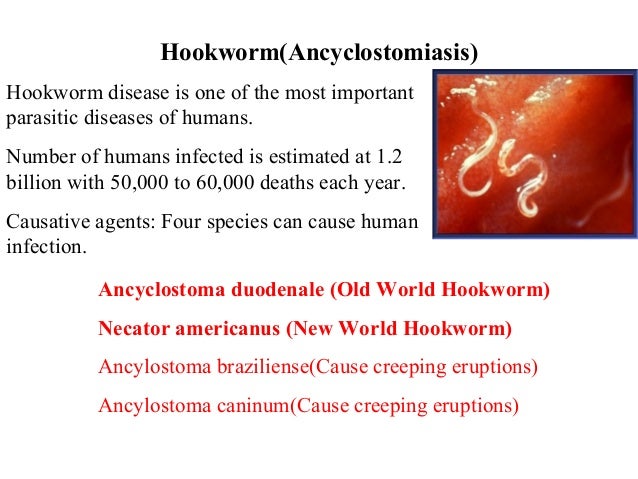
Stool should be examined within several.Hookworm infection affects 430 million people worldwide, causing iron deficiency, impaired cognitive development, and stunting in children. Hookworm infection is diagnosed by identifying hookworm eggs in a sample of stool. Diagnosis of Hookworm Infection. Parasites in your body can cause parasitic infections that can lead to a long list of serious symptoms and health issues, including digestive issues, fatigue, brain fog, headaches, iron deficiency anemia, nutrient deficiency, weakness, chronic pain, depression, anxiety, adrenal fatigue, liver. A human body can become a host to certain parasites.

Individuals living in this high-risk environment within the United States continue to have stool samples positive for N. Soil studies detected one (2.9%) Cryptosporidium species, and Toxocara serology assay detected one (5.2%) positive in this population. Americanus contained low levels of parasite DNA (geometric mean 0.0302 fg/μL). Stool tested positive for N. Americanus, four (7.3%) for Strongyloides stercoralis, and one (1.8%) for Entamoeba histolytica. We found that, among 24 households, 42.4% reported exposure to raw sewage within their home, and from 55 stool samples, 19 (34.5%) tested positive for N.
Waste from pet dogs, cats, and raccoons is a.Intestinal parasitic infections have a significant impact on health outcomes and morbidity in adults and children worldwide, ranging from diarrhea and stunting in children to impaired cognitive development from iron deficiency anemia. A note on a couple other hookworm treatment protocols that have been shared and discussed on various groups.Hookworms and roundworms are tiny parasites that can be passed from animal feces to humans. The IDEXX fecal antigen test may be more accurate, but it would still be prudent to continue Advantage Multi for a few more months past a negative result.
Some types of parasites reside in the cecum, which is a pouch-shaped area in the intestine. 3Why the usual test isn’t enough. 4– 6 Beyond its health impact, the anemia it induces is linked to a moderate economic burden ranging up to $139 billion annually. 3 This large contribution of hookworm infections to the YLDs among those with nematode infections is due to the link between hookworm disease and anemia in children. 2 Among those infected with intestinal nematodes, hookworm infections are associated with the greatest years lived with disability (YLDs), with recent estimates indicating that human hookworm disease is associated with 4.1 million disability-adjusted life years.
These soil-transmitted helminths are mainly found in areas where sanitation and hygiene are poor, 7 most commonly in resource-limited countries. Conditions for larval survival, include moist and temperate environments. Transmission requires fecal contamination of soil and dermal penetration of human hosts.
10 However, because of posttreatment reinfection and widespread transmission, hookworm infection and disease continued to persist in the southern United States, especially in areas of extreme poverty. 9 After these interventions, there were increases in school enrolment, attendance, and literacy, and those within the treated cohort had substantial gains in long-term incomes. 8 To control the disease, thousands of individuals were treated, decreasing prevalence to 39%. The initial surveys found 53.6% of the population to be infected with hookworm in some areas, the prevalence rose as high as 76%.
13 This part of the United States was identified as one at high risk for intestinal helminth infections. Americanus, and Enterobius vermicularis. In the 1990s, surveillance studies for enteropathogens in southern Alabama show a 30% prevalence for all soil-transmitted helminths combined, including Ascaris lumbricoides, N. 12 With improved sanitation and waste disposal infrastructure, in association with aggressive economic development in the southern United States, the prevalence of hookworm infection decreased.
:max_bytes(150000):strip_icc()/natural-remedies-for-intestinal-parasites-88232_final-df66327f179d4afe9c24c296d29d255c.png)
According to the 2010 US Census, Lowndes County, has 5,270 houses with a 11,299 total population. The results of this study will provide insight into disease burden within this community and a basis for further study on possible risk factors, intervention, and effects on the community.The study was performed in Lowndes County, an area in Alabama known to have low per capita income. Given continued poverty in these areas such as Lowndes County, lack of access to contained septic systems, and potential exposure to raw sewage, intestinal helminth infection likely persists despite previous interventions. The goal of this study seeks to address the current prevalence of helminthic and protozoan infections and determines correlation with sewage exposure in an economically challenged region of the southern United States.
There were single individuals from seven homes, four homes with two subjects, seven homes with three subjects, three homes with four subjects, one home each with five, six, and eight subjects, respectively. A total of 66 subjects were enrolled in the study from a total of 24 homes. Enrolment goals of 100 subjects were planned, all subjects enrolled were African American. Dwellings and individuals were preselected by ACRE organizers from areas with poor sanitation and used open sewage systems as a means of waste management.
Participants were excluded if they have ever traveled outside the United States or were under 2 years of age, pregnant, HIV-positive, or immunocompromised. Before participating in the study, each participant or guardian signed a written consent form. The questionnaire included information regarding sex, age, previous travel outside the United States, prior history of parasitic infections, exposure to sewage within the home, asthma, and diarrheal symptoms.
Samples were repeated for discordant results. 19 All controls (positive, negative, and a pBR322 plasmid internal control) were performed in triplicate with subject samples in duplicate. 19 DNA concentrations were calculated using parasite plasmid standard curves. Samples were analyzed on an ABI ViiA 7 Real-Time PCR System (Applied Biosystems) using default parameters for fast chemistry and 40 cycles. 19 Species-specific primers and 6-carboxyfluorescein-labeled Minor groove binder probes (Applied Biosystems, Foster City, CA) were selected for each of the eight parasites tested, including helminths ( Ascaris lumbricoides, Trichuris trichiura, Strongyloides stercoralis, Ancylostoma duodenale, and N.americanus), and protozoa ( Giardia lamblia, Cryptosporidium species, and Entamoeba histolytica) 19 ( Supplemental Table 1). 19 Parasite DNA was detected using a multiparallel quantitative real-time PCR (qPCR) protocol.


 0 kommentar(er)
0 kommentar(er)
